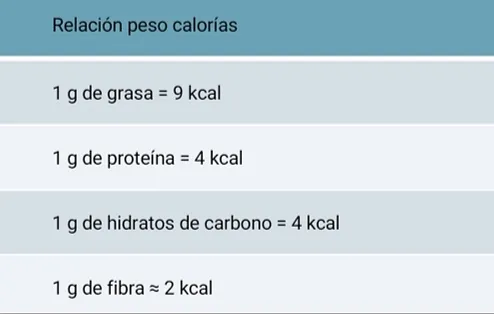ByOnlinecourses55

Energies and nutrients in food - nutrition
In order to stay alive and be able to work, man needs an uninterrupted supply of energy, whether for physical activity, for muscular work, for the normal functioning of the nervous system and the heart, or for processes related to the development of the organism, tissue repair, reproduction and regulation of body temperature.

How does the body obtain energy?
Food consumption is the way to supply energy to the body, this energy being obtained, specifically, from the oxidation of carbohydrates, fats and proteins.
The exact amount of energy obtained when a food is totally oxidized or metabolized to produce carbon dioxide and water is known as energy or caloric value. If we refer to kilocalories it can be observed in the table below.
The average value acquired by the oxidation of food:

All foods, in varying proportions depending on their particular macronutrient content [carbohydrates, fats and proteins], are potential sources of energy. Examples: foods rich in fats are more caloric than those containing mainly carbohydrates or proteins.
In the case of alcohol, which is not a nutrient, it provides metabolically useful energy [with a yield of 7 kcal/g] when ingested in moderate doses [less than 30 g ethanol/day]. Vitamins, minerals and water alone do not constitute energy sources.
For the planning of diets it is essential to know about the nutritional composition of foods and the different groups in which they are classified. This information is necessary as a guide when choosing the foods and menus that will be part of the diet.
Every individual will require to consume regularly a certain quantity/quality of energy and about 50 nutrients contained in food, from this depends on their health from the nutritional point of view. From the various adaptations that man has developed throughout his evolution, nowadays, he can obtain the necessary energy and nutrients from a wide range of products and foods.
The Spanish Food Code recognizes that foods are those substances or products of any nature that, due to their components, characteristics, preparation and state of preservation, are suitable for frequent and suitable use for normal human nutrition, as food additives or as dietary products in specific cases.
It was mentioned that alcohol, despite not being a nutrient, contributes metabolically usable energy, but when it exceeds the accredited consumption limit, it induces contrary reactions.
Alcohol consumption on an empty stomach results in a higher absorption rate and, once assimilated, it reaches and is dosed by all body fluids and cells. Consumption of this type results in blood alcohol levels [BAC] of about 0.750 g/l if 30 g of alcohol is consumed, an amount at which a person will feel euphoria, disinhibition and loss of reflexes.
Alcohol metabolization occurs mainly in the liver at a rate of 60-200 mg/kg. In the case of women, it is metabolized less efficiently and, due to the lower proportion of body water, a higher BAC is usually reached after ingesting 30 g of alcohol. On this basis, in some countries an ethanol intake of ? 20 g/day is recommended.
Spices and condiments: spices, aromatic herbs and condiments such as salt, vinegar, etc., used to add or improve flavor and/or aroma, although they do indeed provide some nutrients and numerous phytochemicals, have little nutritional value since they are ingested in very small doses.
Loss of vitamins: the different culinary processes that constitute the treatment of foods, to improve their hygienic and gastronomic quality, change their nutritional value. Some processes result in an increase in nutritional value, but in others it decreases due to the loss of some of its nutrients. Examples: Variable amounts of some vitamins, mainly water-soluble vitamins, may be lost during the cooking time of foods.
Minerals, although they are not ruined by thermal treatments, can be lost in the cooking water or in the liquids released by the meat.
In the case of water-soluble vitamins, the loss will depend on the culinary process to which they are subjected: frying, baking, boiling, roasting, etc.
Fortification or enrichment of foods: these two terms are generally used as synonyms, and both refer to a food or food product to which certain nutrients have been added in order to restore or increase its nutritional value. That said, the two terms refer to processes with different characteristics.
Some specialized techniques, such as the refining of flours and cereals in general, report alarming losses of minerals and vitamins with respect to the content of the whole grain. Likewise, the elimination of fat from many foods to reduce their caloric value leads to the loss of fat-soluble vitamins, such as a or d. Because of this, fortification restores or exceeds the initial levels of the nutrients subtracted in the handling of the food.
The term fortification is adjusted to situations in which a particular nutrient is added to a food that was not originally present. The addition of iodine to table salt is the most common example of fortification. It is essential to choose the ideal food and the nutrients to be added. Milk, for example, is a good option for fortifying certain nutrients, mainly those intended for children.
¨light¨ or light products: nowadays we are experiencing a new food culture where the use of the so-called ¨light¨ or light products has increased notoriously. The ¨light¨ products [of low or reduced caloric value, specially designed to control body weight], are those in which some of their components or ingredients have been annulled or reduced, altering their caloric power and, therefore, their energetic contribution.
Examples:
As mentioned above, fat adjustment has the effect of lowering the energy content. A clear example is the reduced fat content of whole, semi-skimmed and skimmed milk, where semi-skimmed milk contains 1.5 percent fat and skimmed milk less than 1 percent fat, while whole milk contains about 3.5 percent fat.
The treatment of low-fat foods not only has consequences in terms of energy intake, but also involves the reduction of cholesterol and the loss of vitamins such as d, e or vitamin A. That said, this should not be assumed to be a cause for concern, it is a common international practice to enrich skimmed products with these vitamins.
Apart from the above, there is no difference in other nutrients. The calcium or protein content is practically the same as in the original products. In summary, skimmed dairy products report a very low caloric value, and at the same time contain a higher concentration of nutrients, being their consumption recommendable for those who wish to lose weight or who, due to some ailment, etc., must reduce the consumption of fat and/or energy.
Nutritional quality in the elaboration of the diet:
How to measure the energy of food:
The measure used in this case is kilocalories. Energy is obtained from nutrients through the consumption of products and the reactions that occur in our body.
There is no correlation between the weight of an organ and the requirement of the amount of energy for its functioning, rather the energy distribution is established based on whether the organ or system is working or not, that is, if it is active or not.
Carbohydrates provide 4 kcal per gram, which means that 1 gram of carbohydrates provides 4 kcal. Proteins provide 4 kcal/g and lipids, 9 kcal/g.
Do you want to know more about holistic nutrition?